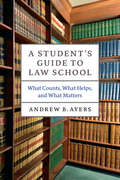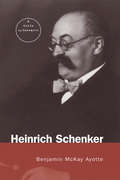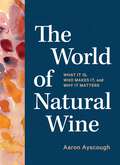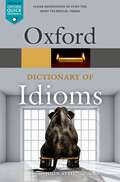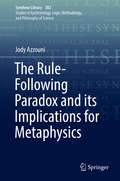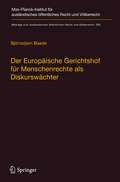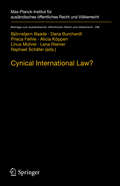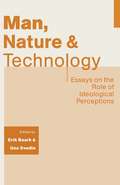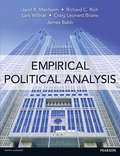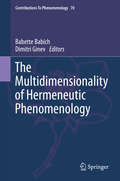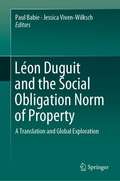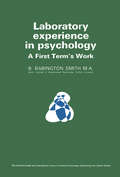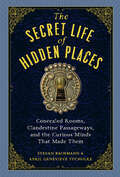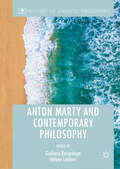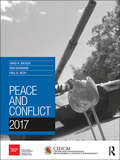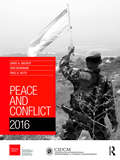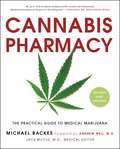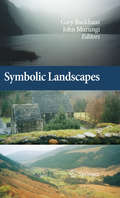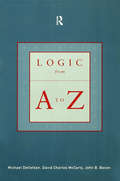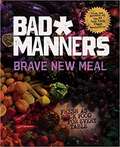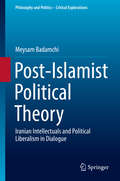- Table View
- List View
A Student's Guide to Law School: What Counts, What Helps, and What Matters (Chicago Guides to Academic Life)
by Andrew B. AyersLaw school can be a joyous, soul-transforming challenge that leads to a rewarding career. It can also be an exhausting, self-limiting trap. It all depends on making smart decisions. When every advantage counts, A Student’s Guide to Law School is like having a personal mentor available at every turn. As a recent graduate and an appellate lawyer, Andrew Ayers knows how high the stakes are—he’s been there, and not only did he survive the experience, he graduated first in his class. In A Student’s Guide to Law School he shares invaluable insight on what it takes to make a successful law school journey. Originating in notes Ayers jotted down while commuting to his first clerkship with then-Judge Sonia Sotomayor, and refined throughout his first years as a lawyer, A Student’s Guide to Law School offers a unique balance of insider’s knowledge and professional advice. Organized in four parts, the first part looks at tests and grades, explaining what’s expected and exploring the seven choices students must make on exam day. The second part discusses the skills needed to be a successful law student, giving the reader easy-to-use tools to analyze legal materials and construct clear arguments. The third part contains advice on how to use studying, class work, and note-taking to find your best path. Finally, Ayers closes with a look beyond the classroom, showing students how the choices they make in law school will affect their career—and even determine the kind of lawyer they become. The first law school guide written by a recent top-ranked graduate, A Student’s Guide to Law School is relentlessly practical and thoroughly relevant to the law school experience of today’s students. With the tools and advice Ayers shares here, students can make the most of their investment in law school, and turn their valuable learning experiences into a meaningful career.
A Student's Guide to Law School: What Counts, What Helps, and What Matters (Chicago Guides to Academic Life)
by Andrew B. AyersLaw school can be a joyous, soul-transforming challenge that leads to a rewarding career. It can also be an exhausting, self-limiting trap. It all depends on making smart decisions. When every advantage counts, A Student’s Guide to Law School is like having a personal mentor available at every turn. As a recent graduate and an appellate lawyer, Andrew Ayers knows how high the stakes are—he’s been there, and not only did he survive the experience, he graduated first in his class. In A Student’s Guide to Law School he shares invaluable insight on what it takes to make a successful law school journey. Originating in notes Ayers jotted down while commuting to his first clerkship with then-Judge Sonia Sotomayor, and refined throughout his first years as a lawyer, A Student’s Guide to Law School offers a unique balance of insider’s knowledge and professional advice. Organized in four parts, the first part looks at tests and grades, explaining what’s expected and exploring the seven choices students must make on exam day. The second part discusses the skills needed to be a successful law student, giving the reader easy-to-use tools to analyze legal materials and construct clear arguments. The third part contains advice on how to use studying, class work, and note-taking to find your best path. Finally, Ayers closes with a look beyond the classroom, showing students how the choices they make in law school will affect their career—and even determine the kind of lawyer they become. The first law school guide written by a recent top-ranked graduate, A Student’s Guide to Law School is relentlessly practical and thoroughly relevant to the law school experience of today’s students. With the tools and advice Ayers shares here, students can make the most of their investment in law school, and turn their valuable learning experiences into a meaningful career.
Heinrich Schenker: A Research and Information Guide
by Benjamin AyotteThis book consists of over 1,500 citations to both primary sources and the burgeoning secondary literature of Heinrich Schenker, annotated and subdivided by category. The citations are supplemented with indices cross-referencing entries according to individual works and analytical topic.
Heinrich Schenker: A Research and Information Guide
by Benjamin AyotteThis book consists of over 1,500 citations to both primary sources and the burgeoning secondary literature of Heinrich Schenker, annotated and subdivided by category. The citations are supplemented with indices cross-referencing entries according to individual works and analytical topic.
The World of Natural Wine: What It Is, Who Makes It, and Why It Matters
by Aaron AyscoughThe most comprehensive and definitive guide to the world of natural wine that every wine lover needs. * Named one of the year&’s best books on wine by The New York Times and Bloomberg Natural wine has nothing to hide. Made from grapes alone—organically farmed, then harvested, fermented, aged, and bottled without additives—it&’s wine that seeks to express, in every sip, its traditional and crucial link to nature. The World of Natural Wine is the book wine lovers need to navigate this movement—because it&’s about so much more than labels and vintages. Meet the obsessive, often outspoken, winemakers; learn about the regions of France where natural wine culture first appeared and continues to flourish today; and explore natural wine in Spain, Italy, Georgia, and beyond. And just as important: find out what must be &“unlearned&” to discover the eye-opening pleasures of drinking naturally.
Oxford Dictionary of Idioms (Oxford Quick Reference)
by John AytoWhat is it to 'cock a snook', where is the land of Nod, and who was first to go the extra mile? Find the answers to these questions (and many more!) in the new edition of the Oxford Dictionary of Idioms. This dictionary uncovers the meanings of myriad phrases and sayings that are used daily in the English language, encompassing more than 10,000 figurative expressions, similes, sayings, and proverbs. More than 400 idioms have been added to this new edition, and comprise recently coined and common sayings alike. New additions include 'back of the net', 'drag and drop', 'go it alone', 'how come?', 'if you ask me', 'make your skin crawl', and 'woe betide'. Illustrative quotations sourced from the Oxford corpora give contextual examples of the idioms and their standard usage, and many entries include background information on the origins of the idiom in question. An updated thematic index makes for easy navigation, and anyone who is interested in the origins and diversity of English vernacular will have hours of fun browsing this fascinating dictionary.
The Rule-Following Paradox and its Implications for Metaphysics (Synthese Library #382)
by Jody AzzouniThis monograph presents Azzouni’s new approach to the rule-following paradox. His solution leaves intact an isolated individual’s capacity to follow rules, and it simultaneously avoids replacing the truth conditions for meaning-talk with mere assertability conditions for that talk. Kripke’s influential version of Wittgenstein’s rule-following paradox—and Wittgenstein’s views more generally—on the contrary, make rule-following practices and assertions about those practices subject to community norms without which they lose their cogency. Azzouni summarizes and develops Kripke’s original version of Wittgenstein’s rule-following paradox to make salient the linchpin assumptions of the paradox. By doing so, Azzouni reveals how compelling Kripke’s earlier work on the paradox was. Objections raised over the years by Fodor, Forbes Ginsborg, Goldfarb, Tait, Wright, and many others, are all shown to fail. No straight solution (a solution that denies an assumption of the paradox) can be made to work. Azzouni illustrates this in detail by showing that a popular family of straight solutions due to Lewis and refined by Williams, “reference magnetism,” fail as well. And yet an overlooked sceptical solution is still available in logical space. Azzouni describes a series of “disposition-meaning” private languages that he shows can be successfully used by a population of speakers to communicate with one another despite their ideolectical character. The same sorts of languages enable solitary “Robinson Crusoes” to survive and flourish in their island habitats. These languages—sufficiently refined—have the same properties normal human languages have; and this is the key to solving the rule-following paradox without sacrificing the individual’s authority over her self-imposed rules or her ability to follow those rules. Azzouni concludes this unusual monograph by uncovering a striking resemblance between the rule-following paradox and Hume’s problem of induction: he shows the rule-following paradox to be a corollary of Hume’s problem that arises when the problem of induction is applied to an individual’s own abilities to follow rules.“The book is clearly and engagingly written, and the conclusions are well-argued-for. (Depressingly well-argued-for in the case of Chapter 3, as I've always been partial to Lewisian responses to Putnam's model-theoretic argument--I'm rethinking that now.) And the proposed solution to the rule-following paradox really is novel.” Joshua Brown - Gustavus Adolphus College
Der Europäische Gerichtshof für Menschenrechte als Diskurswächter: Zur Methodik, Legitimität und Rolle des Gerichtshofs im demokratisch-rechtsstaatlichen Entscheidungsprozess (Beiträge zum ausländischen öffentlichen Recht und Völkerrecht #263)
by Björnstjern BaadeDas Buch nimmt die aktuelle Kritik am EGMR zum Anlass, die Grundsatzfrage zu stellen, welche Rolle dieser gegenüber dem demokratisch-rechtsstaatlichen Entscheidungsprozess seiner Vertragsstaaten einnehmen sollte. Denn die Kritik an der Legitimität des Gerichtshofs, die momentan im Vereinigten Königreich am drastischsten formuliert wird, wirft berechtigte demokratietheoretische Frage auf und ist ernst zu nehmen. Neben einer detaillierten rechtstheoretischen und -methodischen Bewertung der Rechtsprechung wird die Kritik auch aus staatstheoretischer Sicht behandelt. Hierbei werden jeweils interdisziplinär Erkenntnisse der Philosophie sowie der Sprach- und Politikwissenschaften herangezogen. Nach einer ausführlichen Analyse anhand der Wiener Vertragsrechtskonvention werden objektivistische Auslegungsansätze (wie original meaning oder positivisme sociologique) erörtert und zurückgewiesen. Die Kontrolle der Einhaltung prä-existenter Normen ist als alleiniges Erklärungs- und Rechtfertigungsmodell jedenfalls defizitär. Aufgabe des Gerichtshofs ist es auch, den demokratisch-rechtsstaatlichen Entscheidungsdiskurs an seine korrekte Funktionsweise zu binden, seine normative Rationalität sicherzustellen sowie hierfür die Tatsachengrundlage zu prüfen. Hierbei kommt der margin of appreciation und dem sie maßgeblich bestimmenden Faktor der Legitimität der kontrollierten Entscheidung besondere Bedeutung zu. Sie verhindert ihrerseits, dass der Gerichtshof aus seiner Rolle fällt, die darin besteht, als Wächter dieses Diskurses einen Beitrag dazu zu leisten, dass die Institutionen demokratischer Rechtsstaaten ihrer Rolle entsprechen.
Cynical International Law?: Abuse and Circumvention in Public International and European Law (Beiträge zum ausländischen öffentlichen Recht und Völkerrecht #296)
by Björnstjern Baade Dana Burchardt Prisca Feihle Alicia Köppen Linus Mührel Lena Riemer Raphael SchäferAnalysing international law through the prism of “cynicism” makes it possible to look beyond overt disregard for international law, currently discussed in terms of a backlash or crisis. The concept allows to analyse and criticise structural features and specific uses of international law that seem detrimental to international law in a more subtle way. Unlike its ancient predecessor, cynicism nowadays refers not to a bold critique of power but to uses and abuses of international law that pursue one-sided interests tacitly disregarding the legal structure applied. From this point of view, the contributions critically reflect on the theoretical foundations of international law, in particular its relationship to power, actors such as the International Law Commission and international judges, and specific fields, including international human rights, humanitarian, criminal, tax and investment law.
Empirical Political Analysis: An Introduction To Research Methods (PDF)
by James Babb Jarol B. Manheim Richard C. Rich Lars Willnat Craig Leonard BriansThis comprehensive research methods text introduces students, both concretely and theoretically, to a wide variety of techniques, applications, and concerns that are important to political science research.
The Multidimensionality of Hermeneutic Phenomenology (Contributions to Phenomenology #70)
by Babette Babich Dimitri GinevThis book offers new reflections on the life world, from both phenomenological and hermeneutic perspectives. It presents a prism for a new philosophy of science and technology, especially including the social sciences but also the environment as well as questions of ethics and philosophical aesthetics in addition to exploring the themes of theology and religion.Inspired by the many contributions made by the philosopher Joseph Kockelmans, this book examines the past, present and future prospects of hermeneutic phenomenology. It raises key questions of truth and method as well as highlights both continental and analytic traditions of philosophy.Contributors to The Multidimensionality of Hermeneutic Phenomenology include leading scholars in the field as well as new voices representing analytic philosophers of science, hermeneutic and phenomenological philosophers of science, scholars of comparative literature, theorists of environmental studies, specialists in phenomenological ethics and experts in classical hermeneutics.
Léon Duguit and the Social Obligation Norm of Property: A Translation and Global Exploration
by Paul Babie Jessica Viven-WilkschThis book demonstrates the importance of Léon Duguit for property theory in both the civil and common law world. It translates into English for the first time ever Duguit’s seminal lecture on property, the sixth of a series given in 1911 in Buenos Aires. It also collects essays from the leading experts on the social function of property in major civil and common law jurisdictions internationally.The book explores the importance that the notion of the social function of property has come to have not only in France but in the entire civil law tradition, and also considers the wide – if un-attributed and seldom regarded – influence in the common law tradition and theory of property.
Laboratory Experience in Psychology: A First Term's Work
by B. Babington SmithLaboratory Experience in Psychology: A First Terms Work focuses on experimental psychology, which demonstrates a pragmatic, empirical approach that is endlessly adaptable to varying circumstances in determining human experience and through which the information governing human behavior is deciphered. The topics discussed in this book include the demonstrations and eyewitness accounts: fidelity of report; serial reproduction and the assessment of changes of meaning; control or exclusion of meaning; getting beneath recognition; and “weight," a study of physical and perceptual dimensions. The “extent" and “density," a paradigm of perceptual learning; “length" and the development of a frame of reference; and discussion and findings are also deliberated in this text. This publication is valuable to students and researchers conducting work in the psychological field.
The Secret Life of Hidden Places: Concealed Rooms, Clandestine Passageways, and the Curious Minds That Made Them
by Stefan Bachmann April Genevieve TucholkeA spellbinding tour, filled with stories and photographs, of some of the world&’s most fascinating architectural mysteries. This wondrous guide for the curious and the intrepid takes readers on a lushly photographed and lyrically written tour of eighteen of the world&’s most captivating architectural mysteries. Delve into both the secretive places themselves and the eccentric and obsessive minds that created them. Visit a chamber of skulls high in the Swiss Alps, a Japanese temple full of traps, a Parisian apartment locked and untouched since World War II, a Prohibition-era speakeasy in Washington, DC, and a spooky &“initiation&” well in Portugal built by a secret society. How far down can you climb before losing your nerve?
Anton Marty and Contemporary Philosophy (History of Analytic Philosophy)
by Giuliano Bacigalupo Hélène LeblancThis edited collection of eight original essays pursues the aim of bringing the spotlight back on Anton Marty. It does so by having leading figures in the contemporary debate confront themselves with Marty’s most significative contributions, which span from philosophy of mind, philosophy of language and ontology to meta-metaphysics and meta-philosophy. The book is divided in three parts. The first part is dedicated to themes in philosophy of language, which were at the centre of Marty’s philosophical thinking throughout his life. The second part focuses on the problem of the objectivity and phenomenology of time and space, upon which Marty was working in the final years of his life. The final part turns to Marty’s meta-metaphysical and meta-philosophical considerations. The intended audience of this book are primarily scholars and students interested in the relevant contemporary debates, as well as scholars working on the Austrian tradition.
Peace and Conflict 2017 (Peace and Conflict)
by David A. Backer Ravi Bhavnani Paul K. HuthAn authoritative source of information on violent conflicts and peacebuilding processes around the world, Peace and Conflict is an annual publication of the University of Maryland’s Center for International Development and Conflict Management and the Graduate Institute of International and Development Studies (Geneva). The contents of the 2017 edition are divided into three sections: » Global Patterns and Trends provides an overview of recent advances in scholarly research on various aspects of conflict and peace, as well as chapters on armed conflict, violence against civilians, characteristics of rebel and state forces, sexual violence, democracy and civil war, terrorism, human rights conditions, and the results of the updated Peace & Conflict Instability Ledger, which ranks the status and progress of more than 160 countries based on their forecasted risk of future instability (adverse regime change, internal war, state mass killing, non-state mass killing). » Special Feature spotlights work on the relationship between refugees and the diffusion of armed conflict. » Profiles surveys developments in instances of civil wars, peacekeeping missions, and international criminal justice proceedings that were active around the world during 2015. Frequent visualizations of data in full-color, large-format tables, graphs, and maps bring the analysis to life and amplify crucial developments in real-world events and the latest findings in research. The contributors include many leading scholars in the field from the US and Europe.
Peace and Conflict 2016 (Peace and Conflict)
by David Backer Ravinder Bhavnani Paul HuthAn authoritative source of information on violent conflicts and peacebuilding processes around the world, Peace and Conflict is an annual publication of the University of Maryland’s Center for International Development and Conflict Management and the Graduate Institute of International and Development Studies (Geneva). The contents of the 2016 edition are divided into three sections: » Global Patterns and Trends provides an overview of recent advances in scholarly research on various aspects of conflict and peace, as well as chapters on armed conflict, violence against civilians, non-state armed actors, democracy and ethnic exclusion, terrorism, defense spending and arms production and procurement, peace agreements, state repression, foreign aid, and the results of the Peace & Conflict Instability Ledger, which ranks the status and progress of more than 160 countries based on their forecasted risk of future instability. » Special Feature spotlights work on measuring micro-level welfare effects of exposure to conflict. » Profiles has been enlarged to survey developments in instances of civil wars, peacekeeping missions, and international criminal justice proceedings that were active around the world during 2014. Frequent visualizations of data in full-color, large-format tables, graphs, and maps bring the analysis to life and amplify crucial developments in real-world events and the latest findings in research. The contributors include many leading scholars in the field from the US and Europe.
Cannabis Pharmacy: The Practical Guide to Medical Marijuana -- Revised and Updated
by Michael BackesThe most comprehensive and approachable book available on understanding and using medical marijuana. Revised and updated with the latest information on varietals, delivery, dosing, and treatable conditions, Cannabis Pharmacy is "a well-designed and -illustrated and easy-to-use resource"(Booklist) for those considering medical marijuana as a treatment option.In Cannabis Pharmacy, expert Michael Backes offers evidence-based information on using cannabis to treat an array of ailments and conditions. He provides information on how cannabis works with the body's own system, how best to prepare and administer it, and how to modify and control dosage. This newly revised edition is now completely up-to-date with the latest information on the body's endocannabinoid system, which is understood to control emotion, appetite, and memory. Delivery methods including e-cigarette and vape designs are also covered here, along with information on additional varietals and a new system for classification. Cannabis Pharmacy covers more than 50 ailments and conditions that can be alleviated with marijuana. There are currently more than 4.2 million medical cannabis patients in the United States, and there are 33 states plus the District of Columbia where medical cannabis is legal.
Cannabis Pharmacy: The Practical Guide to Medical Marijuana -- Revised and Updated
by Michael BackesThe most comprehensive and approachable book available on understanding and using medical marijuana. Revised and updated with the latest information on varietals, delivery, dosing, and treatable conditions, Cannabis Pharmacy is "a well-designed and -illustrated and easy-to-use resource"(Booklist) for those considering medical marijuana as a treatment option. In Cannabis Pharmacy, expert Michael Backes offers evidence-based information on using cannabis to treat an array of ailments and conditions. He provides information on how cannabis works with the body's own system, how best to prepare and administer it, and how to modify and control dosage. This newly revised edition is now completely up-to-date with the latest information on the body's endocannabinoid system, which is understood to control emotion, appetite, and memory. Delivery methods including e-cigarette and vape designs are also covered here, along with information on additional varietals and a new system for classification. Cannabis Pharmacy covers more than 50 ailments and conditions that can be alleviated with marijuana. There are currently more than 4.2 million medical cannabis patients in the United States, and there are 33 states plus the District of Columbia where medical cannabis is legal.
Symbolic Landscapes
by Gary Backhaus John MurungiSymbolic Landscapes presents a definitive collection of landscape/place studies that explores symbolic, cultural levels of geographical meanings. Essays written by philosophers, geographers, architects, social scientists, art historians, and literati, bring specific modes of expertise and perspectives to this transdisciplinary and interdisciplinary study of the symbolic level human existential spatiality. Placing emphasis on the pre-cognitive genesis of symbolic meaning, as well as embodied, experiential (lived) geography, the volume offers a fresh, quasi-phenomenological approach. The editors articulate the epistemological doctrine that perception and imagination form a continuum in which both are always implicated as complements. This approach makes a case for the interrelation of the geography of perception and the geography of imagination, which means that human/cultural geography offers only an abstraction if indeed an aesthetic geography is constituted merely as a sub-field. Human/cultural geography can only approach spatial reality through recognizing the intimate interrelative dialectic between the imaginative and perceptual meanings of our landscapes/place-worlds. This volume reinvigorates the importance of the topic of symbolism in human/cultural geography, landscape studies, philosophy of place, architecture and planning, and will stand among the classics in the field.
Logic from A to Z: The Routledge Encyclopedia of Philosophy Glossary of Logical and Mathematical Terms
by John B. Bacon Michael Detlefsen David Charles McCartyFirst published in the most ambitious international philosophy project for a generation; the Routledge Encyclopedia of Philosophy.Logic from A to Z is a unique glossary of terms used in formal logic and the philosophy of mathematics.Over 500 entries include key terms found in the study of:* Logic: Argument, Turing Machine, Variable* Set and model theory: Isomorphism, Function* Computability theory: Algorithm, Turing Machine* Plus a table of logical symbols.Extensively cross-referenced to help comprehension and add detail, Logic from A to Z provides an indispensable reference source for students of all branches of logic.
Logic from A to Z: The Routledge Encyclopedia of Philosophy Glossary of Logical and Mathematical Terms
by John B. Bacon Michael Detlefsen David Charles McCartyFirst published in the most ambitious international philosophy project for a generation; the Routledge Encyclopedia of Philosophy.Logic from A to Z is a unique glossary of terms used in formal logic and the philosophy of mathematics.Over 500 entries include key terms found in the study of:* Logic: Argument, Turing Machine, Variable* Set and model theory: Isomorphism, Function* Computability theory: Algorithm, Turing Machine* Plus a table of logical symbols.Extensively cross-referenced to help comprehension and add detail, Logic from A to Z provides an indispensable reference source for students of all branches of logic.
Brave New Meal: Fresh as F*ck Food for Every Table (Bad Manners)
by Bad MannersA new book by the authors of THUG KITCHEN, THUG KITCHEN 101 and THUG KITCHEN: PARTY GRUBBad Manners is back in season with their original plant-based recipes to show you how to shop and cook smarter in this new world so cooking at home doesn't have to be boring as f*ck.If it feels like everything's so beyond f*cked that you just wanna lay down and wait for the earth to reclaim your body, we understand. A food reckoning is unfolding in front of us. Adjustments are difficult and change is scary, but this is an opportunity: a chance for food not just to be different, but better. Any time you open this book, you're stepping into a corner of our kitchen. Try to tune out whatever mushroom cloud of bullshit is happening outside your door: global pandemics, biblical plagues, terrible haircuts, none of that shit matters in here. We'll help you do more than just survive; bitch, you're gonna THRIVE. Sure, this book is full of some bomb-ass recipes and killer photos, but that wasn't enough. Not this time. We wanted to show you how to stock your pantry and store your produce to make it last longer. If we call for an ingredient you're not familiar with or the store is sold out, we give you substitutions. We didn't just give you shortcuts, we're giving you the whole f*cking road map from pantry to prep to pairings to plating. We've got a produce glossary that breaks down a lot of shit you probably never knew (but most def should) about all the fresh stuff in your market. We're here to arm you with all the info you need so that you'll never experience produce panic again.
Post-Islamist Political Theory: Iranian Intellectuals and Political Liberalism in Dialogue (Philosophy and Politics - Critical Explorations #5)
by Meysam BadamchiThis book deals with the concept of post-Islamism from a mainly philosophical perspective, using political liberalism as elaborated by John Rawls as the key interpretive tool. What distinguishes this book from most scholarship in Iranian studies is that it primarily deals with the projects of Iranian intellectuals from a normative perspective as the concept is understood by analytical philosophers. The volume includes analyses of the strengths and weakness of the arguments underlying each thinker’s ideas, rather than looking for their historical and sociological origins, genealogy, etc. Each chapter develops a particular conjectural argument for the possibility of an overlapping consensus between Islam and political liberalism, though the arguments presented draw upon different Islamic, particularly Shia, resources. Thus, while Shabestari and Soroush primarily reason from a modernist theological or kalami perspective, M.H.Tabatabai and Mehdi Haeri Yazdi’s arguments are mainly based on traditional Islamic philosophy and Quranic exegesis. While Kadivar, An-Naim and Fanaei are post-Islamist in the exact sense of the term, Malekian goes beyond typical post-Islamism by proposing a theory for spirituality that constrains religion within the boundaries of enlightenment thought. Throughout the book, specific attention is given to Ferrara and March’s readings of political liberalism. Although the book’s chapters constitute a whole, they can also be read independently if the reader is only curious about particular intellectuals whose political theories are discussed.
